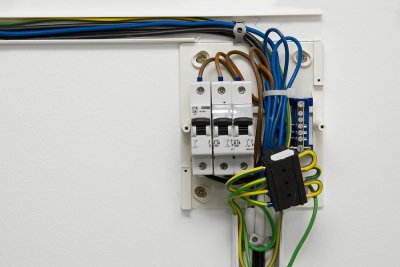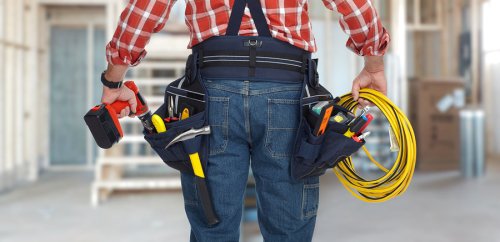-
Fix a GFCI Outlet That Keeps Tripping
Fix a GFCI Outlet That Keeps Tripping
The average home has any number of electrical outlets that get used ever day. Some are basic, and some a bit more complicated. Your home likely has GFCI outlets in areas prone to moisture, such as kitchens and bathrooms. These are the outlets that have two little buttons, labeled “test” and “reset.” If you’ve ever plugged a hair dryer or a stand mixer into one of these and found that they don’t work, you’ve probably pressed each of these buttons, successfully reset the outlet, and gone about your business with the power source that you expected to work in the first place. But what if you press the reset button and nothing happens? Or what if you have a GFCI outlet that keeps tripping repeatedly? Delta Electric is here to de-mystify this everyday household item.
What is a GFCI Outlet?
A Ground Fault Circuit Interrupter (GFCI) outlet is a specialized device designed to protect against electrical shock by monitoring the flow of electrical current. Found mainly in areas with potential water contact, such as bathrooms, kitchens, and outdoor spaces, GFCI outlets are a standard safety feature in modern homes.

How Does a GFCI Work?
A GFCI outlet monitors the electrical current flowing in a circuit. It compares the current going to an appliance with the returning current. The device trips, cutting off electricity, when there is a difference between the two currents. This difference usually indicates a ground fault, where electricity is escaping the circuit – potentially through a person, leading to a dangerous shock.
Reasons Your Ground-Fault Circuit Interrupter Outlet Keeps Tripping
- Ground Faults: The most common cause for a GFCI tripping is a ground fault. This occurs when electricity is leaking somewhere along the circuit.
- Overloaded Circuit: When too many appliances are running simultaneously, it can overload the circuit, causing the GFCI to trip.
- Wet Conditions: GFCIs in areas like bathrooms or kitchens may trip due to moisture, as they are highly sensitive to water.
- Faulty Appliances: If an appliance is malfunctioning or damaged, it can cause leakage currents that trip the GFCI.
- Wiring Issues: Problems with the electrical wiring, such as loose connections or worn insulation, can lead to GFCI tripping.
How to Fix a GFCI Outlet that Keeps Tripping?
- Identify and Unplug Appliances: Start by unplugging all appliances on the GFCI circuit to see if the problem is with a specific device.
- Check for Moisture: Ensure that the outlet and surrounding area are dry. Moisture is a common cause of GFCI trips.
- Inspect Wiring: Look for any visible signs of damaged or loose wiring and have them repaired.
- Replace Faulty Outlet: If the GFCI outlet itself is faulty, it may need replacement.
How to Reset and Test a Tripped GFCI: Step by Step
- Locate the GFCI Outlet: Identify the tripped GFCI outlet. It will have two buttons: a test button and a reset button.
- Press the Reset Button: Firmly press the reset button. If the outlet does not reset, there may be a persistent ground fault or the GFCI may be defective.
- Test the Outlet: After resetting, press the test button. The reset button should pop out, indicating the GFCI is functioning correctly.
- Check Connected Devices: Plug in devices one at a time to determine if any specific appliance is causing the trip.
Solutions When Your GFCI Outlet Is Tripping
- Address Moisture Issues: Keep GFCI outlets and surrounding areas dry. Use covers for outdoor outlets.
- Spread Out High-Wattage Devices: Avoid overloading the circuit by spreading out high-power consuming appliances.
- Regular Testing: Regularly test GFCI outlets to ensure they are functioning correctly.
- Professional Inspection: If the problem persists, call Delta Electric. Our experienced technicians will diagnose and fix any underlying electrical issues.
Risks Associated with a GFCI Outlet that Won’t Stop Tripping
When a GFCI (Ground Fault Circuit Interrupter) outlet keeps tripping, it indicates potential risks and hazards that should not be ignored. Here are some of the key risks and hazards associated with a frequently tripping GFCI outlet:
- Electrical Shock: The primary role of a GFCI outlet is to prevent electrical shocks. If it keeps tripping, it might be due to a ground fault, which poses a risk of electrical shock, especially in wet areas like bathrooms and kitchens.
- Fire Hazard: Constant tripping can sometimes be a sign of an overloaded circuit or faulty wiring. Such conditions can create excessive heat in electrical wires, posing a fire hazard.
- Damage to Appliances: Fluctuations in power supply caused by a tripping GFCI can damage sensitive electronic equipment and appliances, leading to costly repairs or replacements.
- Hidden Electrical Problems: A GFCI that trips frequently might be indicating deeper, hidden problems in your home’s electrical system, such as damaged insulation, wiring faults, or issues with connected appliances.
- Water and Electricity Risks: In areas where water is present, such as bathrooms and kitchens, a failing GFCI increases the risk of electrical accidents, as these outlets are specifically designed to prevent electric shock in wet conditions.
Schedule an Inspection with Delta Electric
It is important to address the root cause of why the GFCI is tripping. This might involve inspecting and repairing the electrical wiring, replacing faulty appliances, or even replacing the GFCI outlet itself. If you have a GFCI outlet that keeps on tripping, you may have an underlying electrical issue that may present a safety risk to you or your home. Rather than guess about it, schedule an inspection with Delta Electric. During our service appointment, we will thoroughly inspect and diagnose your situation, providing an expert solution to make sure your property and family stay safe from potential hazards. We provide unparalleled service no matter what electric project you need our help with. Contact us today to schedule a service appointment. You can call us or fill out our online contact form for a speedy response.
-
Signs That Your Office Should Be Rewired
If your commercial office is more than a decade old, chances are that it may be in need of services from a commercial electrician. Along with checking your breaker box and grounding, your electrician serving San Jose will also be able to determine whether your electrical wiring is in need of an upgrade. By investing in new electrical wiring for your office building, you can help to keep your facility in safe condition for all of your daily operations.
There are a few common signs that your office is ready for rewiring services. With services from a commercial electrician, you can determine whether your existing wiring was installed using materials that are now considered to be outdated. Office buildings that contain aluminum electrical wiring should be renovated with the latest wiring materials. Another sign that your office needs to be rewired is when you start to notice that your current system is not providing enough power to your switches or outlets.

-
How to Reset a GFCI Outlet
Most homeowners know very little about their electrical system. While you don’t need to be a professional electrician to be a responsible homeowner, it helps to know a few basic things. For example, it’s good to know that a GFCI outlet, or ground-fault circuit interrupter outlet, can be reset when it trips. This video provides a good introduction to GFCI outlets as well as a simple demonstration of how to reset a tripped outlet.
GFCI outlets are designed to automatically trip under potentially dangerous circumstances—for instance, when a blow dryer is dropped into a tub. When this occurs, the reset button (the top button) is in while the test button is out. To reset the outlet, simply press the reset button and power should be restored to the outlet. If it isn’t, you should call a San Jose electrician.
RECENT POSTS
categories
- Uncategorized
- Delta Electric
- Commercial Electrical
- Residential Electrical
- Electric Circuits
- Dedicated Circuits
- Circuit Breakers
- Electrical Panels
- Electrical Wiring
- Safety Inspections
- copper wires
- Electrician San Jose
- Trained Electricians
- Electrical Services San Jose
- Malfunctioning Electrical Outlets
- Circuit Breaker
- Grounding
- safety
- Flickering Lights
- Arc Fault Breakers
- electrical system
- Aluminum Wiring
- Circuit Interrupters
- House Surge Protection
- Zinsco Panel Warnings
- Wiring Conversion
- GFCI outlet
- professional electrician
- Knob-and-Tube Wiring
- modern home electrical system
- Fuses
Archives
2024
2023
2018
2017
- December (4)
- November (4)
- October (5)
- September (4)
- August (4)
- July (4)
- June (4)
- May (4)
- April (4)
- March (3)
- February (4)
- January (3)
2016
- December (3)
- November (4)
- October (4)
- September (4)
- August (4)
- July (4)
- June (4)
- May (4)
- April (4)
- March (4)
- February (4)
- January (4)
2015
- December (4)
- November (4)
- October (4)
- September (4)
- August (3)
- July (4)
- June (4)
- May (3)
- April (4)
- March (4)
- February (2)
2014
- December (3)
- November (4)
- October (4)
- September (6)
- August (2)
- July (3)
- May (2)
- April (1)
- March (2)
- February (1)
- January (1)

